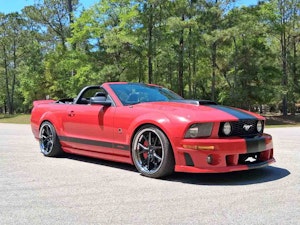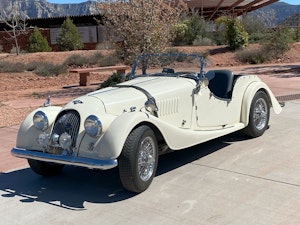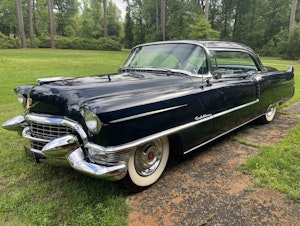Media | Articles
Fancy Footwork: 8 Cool Wheels from Autorama
Every year since 1964, hot-rod builders from all over North America have travelled to Michigan to pursue “the Nobel Prize of hot-rodding,” the Don Ridler Memorial Award, at the Detroit Autorama. Any participant in the three-day event is eligible, as long as the vehicle is operable and has never appeared at any other show.
Winning the Ridler requires a car with an impeccable attention to detail. Builders go to great lengths to leave no stone unturned, powdercoating and chroming chassis bits that you would never see without the help of a mirror or two. One of the most important details to get right on a car are the wheels. As a certified wheel dork, I love seeing the creativity and variety of cool rolling stock at the Detroit Autorama. Here’s a look at some of our favorite wheels from last weekend’s show.
Meshtastic

Pro-touring builds answer the question, “What if we take a vintage muscle car and make it perform like a modern one?” The style, which originated in the mid 1990s and saw a boom in the 2010s with outfits like the Ringbrothers, borrows heavily from motorsports—both aesthetically and parts-wise. And nothing says motorsports quite like mesh wheels. The mesh-style wheel was pioneered by Jim Hall, the creator of the Can Am Chaparral race cars, and later copied endlessly by companies such as BBS and CCW. (Hall reportedly regrets not securing the intellectual rights for the design). The multi-spoked, forged-aluminum CCW LM20s on this Road Runner are probably as no-nonsense as a mesh wheel can get.
Many, Many Spokes

Speaking of spokes, Autorama had plenty of them, especially in the lowrider section. Wire wheels, particularly of the small-diameter 100-spoke variety, have long been a staple of cars that bounce up and down on hydraulics. (That said, one of the most famous lowriders rides on Cragars). The wheels featured here are not Daytons, the century-old manufacturer that is the Kleenex of wire wheels, but rather Luxors, a more recent American brand.
Deep Dish

The 1939 Ford, like many prewar cars, has bulbous, pontoon-like fenders that could fit a lot of wheel and tire. And many enterprising hot-rodders and customizers have done exactly that—whether to fit a big slick to put the power down or just to fill the void for aesthetic purposes. This particular Deluxe Coupe goes wild with width. The 19-inch forged aluminum Boze Alloy rear wheels are 12 inches wide.
Marketplace
Buy and sell classics with confidence
Big Blades

If you are going to spend the BIG BUCKS necessary to build a highly customized contender for Autorama, you might as well go all the way with some one-off wheels. The owner of this 1990 GMC truck took inspiration from the fourth-generation Corvette’s “Saw Blade” wheels, albeit in a much larger diameter. The wheels, which are 20 x 8 inches up front and 20 x 11 in the rear, were designed and machined from billet aluminum by Sage Speed & Custom.
Fuchs for the People

Fuchs wheels might be more associated with Porsche, as they were a factory option, but the fat five-spokes are also popular with the modified Volkswagen crowd. The chrome Fuchs on this Karmann Ghia contrast nicely with its matte lavender paint.
Real Steel

This GT-2 Camaro race car was way more go than show. Sports Car Club of America Grand Touring classes are for tube-framed “silhouette” cars that don’t have much in common with their road-going siblings. Although cars in the GT-2 class can run any size wheel and tire, so long as they don’t exceed 12 inches of width in the front and 13.75 inches in the rear, this car runs 15-inch-diameter steel wheels made by Basset. Basset wheels have long been popular with circle-track racers and road racers alike, because of their durability and relative affordability.
Satisfying Symmetry

Work, a Japanese brand known for making high-quality aftermarket wheels since 1977, has always been a master at radial symmetry. These Work Equip 40s really do it for me, especially because the number of lug holes matches the number of spokes.
Put It All on Red

I’d like to think that the riff from Motörhead’s 1980 speed metal classic “Ace of Spades” inspired this choice of hubcap. I know that song is more about cards rather than roulette, but lead singer Lemmy Kilmister, who was a fan of all types of gambling, likely would have approved.




















None of these wheels shown have any appeal to me at all. I hate to say it but some are outright ugly. Give me Cragar S/S’s, or Keystone’s similar wheel, American Racing Torque Thrust D’s, Minilite’s, or the old BBS alloys with a gold lattice center and silver rims. Sometimes no matter how hard someone tries there is just no improvement on originals.
Whaaat? No deep dish, Cragar SS mags? Sorry, but I’m old school and they looked awesome on my ’73 El Camino…what you presented was nothing-burgers…
It’s hard to beat SS Cragar Chrome Mags !
This article hit a nerve. When it comes to cars, the wheels are my pet peeves. First peeve, asymmetrical wheels, both left and right need to point in the same direction; which means you have to have two different wheels (one pointing clockwise and the other pointing counterclockwise). Second peeve, any wheel taller than 15″ on a classic car (unless it is a full on rod). Third peeve, those gold multi spoke wheels as shown in the article (unless on a pimpmobile). Final peeve, one, two or three spoke wheels (which, fortunately seem to have fallen out of favor).
I would suggest another exception to taller than 15″ on a classic. That is when the factory originally installed a bigger wheel. Old VWs and early Porsches had factory original 16″ wheels.I’m sure there are others with taller than 15″.
None of them fit the car they are on. Real steel and maybe all the spokes, but way too modern on classics just doesn’t work for me.
Not a fan of any of them and the grotesque wheels on the custom are the worst. I did like the wheels on the Ridler winner.
All: let’s get down to it, factory stylists (esp. high end cars) have a certain knowledge, or “flair” when enhancing their creations. For me, the classic aftermarket wheel is the “Crager S.S.”.
Nothing comes close on American Iron.
British: “Mini-Lite”. Benz, Beemer: factory style cast wheels.
Personally: big wheels with “rubber band” tires don’t cut it, the “bad boy outlaw look” is for a certain small segment of enthusiasts.
UHHH, “dubs” on a 560 SEC? Nah.
Good calls Mike. Is it possible that no good new designs have come along in the past 50 years? Minilites for me and I can’t wait for black wheels to make their exit.
It just goes to show that “reinventing the wheel” is not needed. The classics from Italy, Compagnola, etc, 1960s, 70s are great, Mini-Lights, five spoke American mags…all with finishes that are real, something you’d se on a performance car, no gaudy bright chrome or GOLD.
UGLY, no winners here! That about covers it.
None of them. But if I was forced to choose. It would be Satisfying Symmetry.
The best wheels are either Cragers S/S or Chevy Rally Wheels.
Wheels must be in context. Very hard without a complete picture of the car. Personally Iean toward painted Magnum 500s and beauty rings.
Sorry, I agree with the folks who said “None”. For me the classic Torque Thrust with polished rims and gunmetal spokes are the ones. Crager SS as a distance second.
A lot of custom spoked rims are a distraction to the beauty of the car. Period correct styling makes a lot of sense for the classics i.e., American Racing and Cragar. For instance, I think Big Blades could still have pulled it off with good old fashioned chrome reverse rims and Baby Moon Hub caps??
Nope. Nada! Chose ‘D’, none of the above.